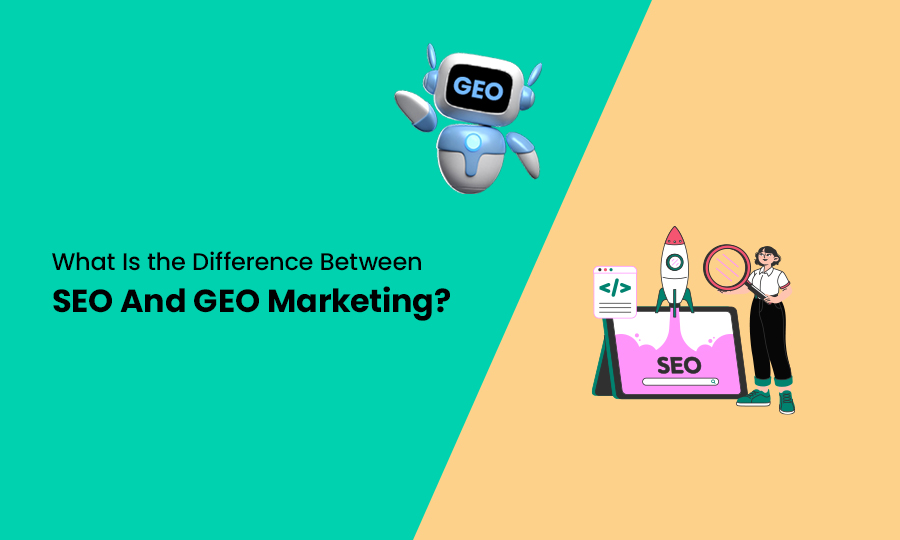Artificial intelligence is taking control of all tech-related resources. So, in digital marketing, GEO (generative engine optimization) has a significant effect. Now you also design content for GEO marketing to get more website traffic. Until now, SEO is the queen of all digital marketing strategies. So, you may be confused about GEO vs SEO marketing. But in this guide, you can explore which marketing strategy is best for your business in GEO or SEO.
In this digital world, most of the businesses use Search Engine Optimization(SEO) to rank their website on Search engines like Google, Bing, and Yahoo. Almost 70% of companies use SEO strategy and get about 5 times the return (ROI) for every dollar they spend.
However, the generative engine optimization (GEO) is the new wing of digital marketing. As it is evolving, the number of users may be less than traditional SEO. GEO is basically used for AI-powered search engines like ChatGPT (with browsing), Google SGE (Search Generative Experience), and Microsoft Copilot (Bing Chat).
Traditional SEO practices will enhance your website’s search engine rankings through organic traffic. The SEO marketing strategy comprises keyword research, content quality, mobile optimization approach, technical SEO, on-page and off-page SEO, and so on.
Moreover, the Generative engine optimization involves structured data, user queries, and optimizing AI-generated responses. In this process, your website should be ranked high in AI-driven search engines.
Though both SEO and GEO focus on improving your website’s visibility, but on separate platforms. So, their marketing strategy and content structure will be different. However, most people want to know about GEO vs. SEO marketing. In this blog, you will have a brief idea about both marketing strategies and so on.
What is Search Engine Optimization(SEO) Marketing?
SEO is an acronym for Search Engine Optimization. Traditional SEO is like a digital map that helps customers find your business online!
Almost 81% of people conduct a Google search before purchasing. If your website ranks at the top on search engines, then it can be a good choice for your targeted customers. SEO marketing involves relevant keywords, content creation, mobile-friendly design, link building, and page speed so that everyone can access your website. This approach can bring you new customers for your services.
Let’s say you own a bakery. You will need people at some point to grow your business, right? That’s why you need SEO. When people search for “best bakery shop near me”, your website will pop up on search engines. It’s important to make sure that search engines can find your website when people type in certain terms. Traditional SEO will magnify your online visibility for search engines.
Why SEO Is Important for Digital Marketing?
Almost 60% of businesses use a digital marketing strategy to enhance their online visibility. There are so many other strategies, like email marketing, social media campaigns, video, and content marketing. However, traditional search engine optimization strategies are the most effective among them.
- Brings organic Traffic: The traditionalSEO relies on budget-friendly tactics, and you don’t have to run paid ads to attract new customers.
- Long-term success: As the most professional digital marketers design an SEO campaign for your business. So, you can gain huge success and sustainable growth.
- Higher ROI & trust: Traditional SEO enhances the legitimacy of your website through the search rankings. As your website ranks higher on search engines, you will likely see an increase in organic traffic and visibility to potential customers. This can raise higher conversion rates and eventually more profits for your business.
- Ability to adapt: As AI-driven search becomes more common, traditional SEO techniques are changing to focus more on user intent and content structure.
- Better user engagement: Technical SEO relies on page speed, mobile friendliness, and other technical aspects like removing broken links. So, it will help to give your users a better experience on your site.
What Is Generative Engine Optimization(GEO) Marketing?
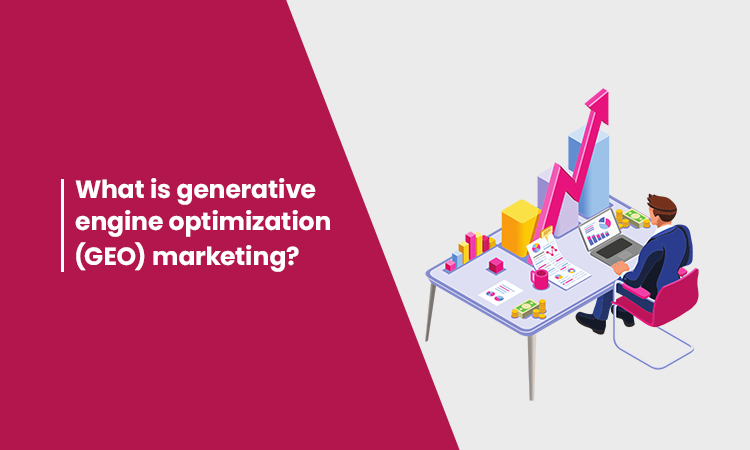
Generative Engine Optimization (GEO) marketing is a new feather in the digital marketing strategy. It will optimize content for AI-powered search engines and generative AI. Unlike traditional search engines, which aim to rank web pages higher in traditional search engine results, GEO marketing targets a website’s visibility in AI-generated responses and summaries.
Why Is GEO Important for Marketing?
- Respond directly to users- GEO ensures your content appears in AI-driven search engines when people ask questions. It will provide direct answers rather than websites. GEO strategies are to make your content responsive for generative AI.
- You Stay Visible in AI Search engines- Unlike traditional search engines that provide a list of links, AI engines provide users direct answers. GEO strategies help your website get included in these answers. Thus, even if they don’t visit a search engine’s homepage, more people will be able to see your brand name.
- Emphasize Content and Trust- GEO marketing is about optimizing content so AI tools can comprehend and trust it. That requires clear writing, using the right keywords, and showing expertise. This is where E-E-A-T comes in—Expertise, Experience, Authoritativeness, and Trustworthiness.
- Built for the Future of AI- With the rise of generative AI research and tools that use AI-generated content, marketers must create helpful, original, and well-structured content. GEO makes your website unique in this new search paradigm.
Related: How Generative Engine Optimization (GEO) Is Changing the Future of Search?
GEO vs SEO: Differences in Marketing Strategy

There are various differences in marketing regarding GEO vs. SEO. Following are those differences, and then choose your marketing strategy according to your need.
- Fundamental Approach
- Traditional SEO improves websites for traditional search engines with relevant keywords, meta descriptions, and structured data to improve search engine rankings and organic search results.
- Generative Engine Optimization (GEO) targets AI-powered search engines and generative AI platforms. It features content that can be processed by AI systems to produce personalized answers to user queries.
- Content Strategy
- Strategy for SEO: Traditional SEO practices are mostly about researching keywords, writing content around specific search terms, and using backlinks and technical SEO to make a website more apparent.
- GEO Strategy: GEO focuses on comprehending search intent to develop in-depth content to discover user needs. You have to structure your content in ways that AI-driven search platforms can easily access and transform into AI-generated responses.
- Technical Implementation
- SEO Implementation: Traditional SEO comprises maximizing elements like meta tags, internal links, page speed, mobile optimization, and schema markup to help search engines rank content higher.
- GEO Implementation: Generative engine optimization focuses on high-quality content, E-E-A-T standards (Experience, Expertise, Authoritativeness, Trustworthiness), and develops context-oriented information that AI systems can use to deliver accurate reactions.
- User Focus
- SEO Focus: The goal of traditional SEO is to match relevant keywords to user searches so that your site shows up in organic search results when people type in certain queries.
- GEO Focus: AI-driven search concentrates on recognizing user behavior and needs to deliver content through AI-generated responses that answer questions rather than just linking to websites.
- Measurement
- SEO Metrics: The Successful search engine optimization is measured through search rankings, organic traffic, click-through rates, and keyword positions in traditional search engine results.
- GEO Metrics: The performance of generative engine optimization can be evaluated through AI-generated content, features in Google AI overviews, user engagement with direct answers, and the ability to meet user needs across various AI platforms.
- Adaptation Timeline
- SEO Timeline: Digital marketing continues to use traditional SEO techniques as they remain useful for existing search engines.
- GEO Timeline: Now, more people switch their search from search engines to generative AI. So, in the future, GEO will dominate the market. And it becomes more important to use GEO strategies to ensure long-term search results.
- Integration Approach
- Combined Strategy: Both SEO and GEO optimization strategies can work together in a prominent digital marketing strategy. As GEO make sure that your content is ready for AI systems while SEO maintain your online exposure in traditional search results.
- Evolution Path: As search behavior shifts, traditional SEO relies more on GEO principles. This technique revolves around high-quality content and user intent. It will become the key component of both approaches.
How to Do Research Keywords for GEO vs SEO?
In digital marketing, SEO is the key to success. But you have to develop SEO optimized content to rank better in search results. However, for GEO, you have to optimizing content for generative AI. The following is an in-depth guide to making content for SEO and GEO marketing.
However, you have to focus on relevant keywords (e.g., long tail or short) for SEO. But for generative engine optimization (SEO), you need to focus more on questions. As GEO gives the direct answer to your question on AI engines. This is the basic keyword research difference for GEO vs SEO marketing.
Most of the professional content writers use Google Keyword Planner, AnswerThePublic, Keyword Surfer, Semrush, Google Trends, and Soovle. But among them, Semrush can give the relevant keywords to identify trends and create high-quality content.
What is Keyword Research?
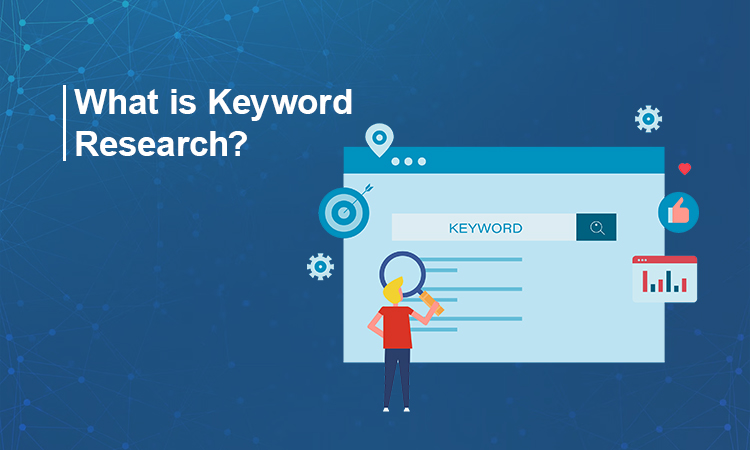
Suppose you are searching for a yoga training center nearby areas. So, you can simply go on Google and search for “Best yoga center near me”, right? And this term you used is known as keywords in the digital marketing industry. As much as you put these most-used keywords, you expand your authenticity and website’s exposure on search engines. This technique will enhance organic search results. In SEO strategy, you need local SEO to attract local customers in a specific region. This keyword research technique is the same for generative engines, also.
Important Keyword Types:
- Primary Keyword: Main topic of your page or blog post
- Secondary Keywords: Related terms, variations, or long-tail keywords
- LSI (latent semantic indexing) Keywords: Semantic words that help search engines understand context
How to Choose Keywords?
- Search Volume –
The number of times a keyword is searched each month.
Higher search volume = more potential visitors. - Keyword Difficulty (KD) –
Tells how hard it is to rank on the first page for that keyword.
Low KD = easier to rank (great for beginners). - Trend –
Shows if a keyword is becoming more or less popular. - CPC (Cost Per Click) –
The price advertisers pay when someone clicks their ad for that keyword (useful for paid search). - SERP Features –
Shows whether the keyword triggers special results like featured snippets, videos, FAQs, etc.
Step-By-Step Guide for Keyword Research in The SEMrush Tool
Suppose you develop a fitness and health website. So, you have to develop relevant content through blog posts related to health and well-being, and also product pages. It will help you to rank content in search engines and AI-driven search engines.
Define the Website’s Focus
First, you have to know what your website is about, so try to cover the following topics-
- What is the website about? (e.g., fitness, baking, tech)
- Who is the target audience? (e.g., beginners, professionals)
- What topics do we require to cover? (e.g., weight loss, workouts, recipes)
This helps you to choose the keywords for relevant queries that match your user searches.
Step 1: Go to semrush.com and log in (or sign up for a free trial).
Step 2: Keyword magic tool-> put your main keyword-> select targeted location-> Search
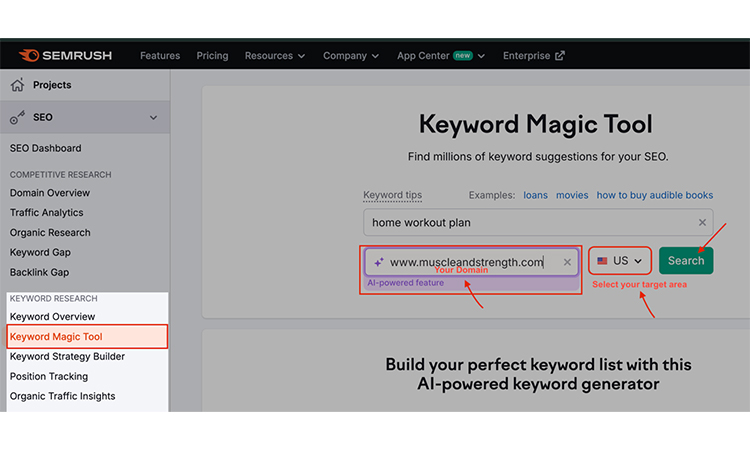
Extra Tip: Enter your domain to get more specific results.
Step 3: Choose Keyword Difficulty (KD) Based on Your Website’s Strength:
Advanced Idea: Lower KD = Easier to rank
If you’re just starting, stick to KD under 30%.
- New Website-> 0–30%-> Easier to rank, low competition
- Growing Website-> 30–60%-> Moderate competition, more traffic
- Established Website-> 60 %+ -> High competition, high reward

For generative engine optimization strategies, you need to focus on questions, as you’re optimizing content for AI-powered search engines.
Select “Question” and get your desired results for AI-driven platforms.
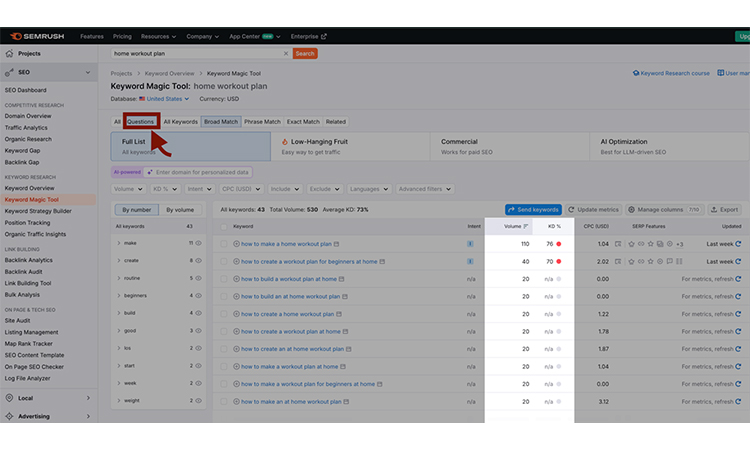
Moreover, you can refine your keywords with the “exclude” option. There are specific products or services you may not provide to your customers. In that case, you can use this option.
Select “Exclude“-> put keywords not relevant for website -> Apply
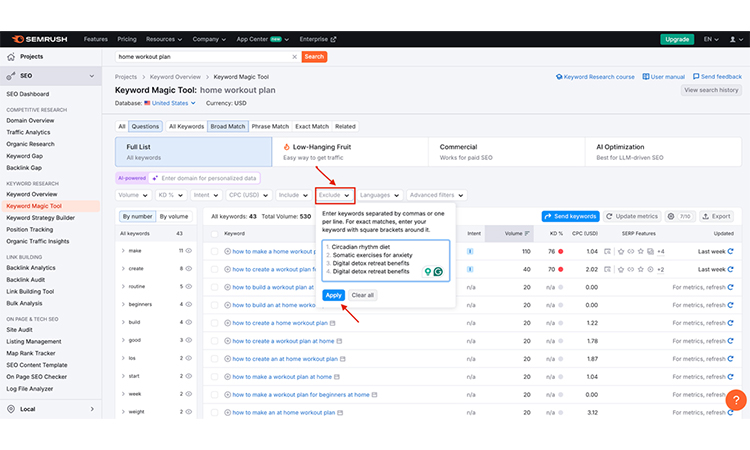
From the above steps, now you have a bunch of keywords to put in your content. These keyword research strategies go with both SEO and GEO.
How To Develop Content Quality for GEO vs SEO?
To improve content quality for GEO vs SEO, focus on clear structure, user intent, accurate information, and natural use of keywords to help both AI and traditional search engines understand your content.
Content structure for generative AI
- How Generative AI Reads Your Content
- Distinct from Humans: AI systems have a different way of reading web pages than humans do. They attempt to comprehend the whole subject rather than only concentrate on keywords.
- Information Processing: AI-driven platforms scan your questions and search for the best response from your content.
- Understanding Connections: AI systems try to interact with various ideas and concepts in your content. Then, generative AI gives you precise answers.
- AI engines love questions.
Generative AI tools like ChatGPT, Google AI Overviews, and Bing Copilot are intended to answer questions, not just match keywords like traditional search engine optimization.
For example:
Instead of targeting “digital marketing tools”,
You could target “What are the best digital marketing tools for small businesses?”
- Making Content AI-Friendly
- Crystal Clear Organization: AI likes content that has easy-to-understand headings, lists, and sections.
- Question-and-Answer Format: You have to put authentic data so that generative AI can pick your content for AI engines.
- Complete Information: AI-driven search engines only select that content which covers a diverse range of data and statistics. So you have to optimizing elements for AI-driven search engines.
- The E-E-A-T Approach
- Experience: Feel free to use examples from your own life to back up what you say.
- Expertise: Talk about how you know about this subject (for example, through schooling or work experience).
- Authoritativeness: Back up what you say with research, facts, and evidence.
- Trustworthiness: Tell the truth, give credit, and make sure the information you give is correct and up to date.
- Technical Considerations for AI
- Schema markup- Schema markup is a special code (written in structured data) that you put in your website to help search engines better understand your content. It tells Google what your page is about — like whether it’s a recipe, article, product, review, event, or FAQ.
- Structured Data: You have to arrange data into clear patterns so that generative AI knows what is important or not.
- Table of Contents: Moreover, this table of data can add a roadmap to your content, helping the AI system to find specific information quickly. Where to use GEO vs SEO Marketing?
- Understanding What People Want
- User Intent: Think about why someone is searching – do they want to learn something, buy something, or find directions?
- Question Prediction: GEO ensures that your content answers more than just the main question people may have.
- User Behavior: However, you have tolook at how people interact with similar content. This will help you make relevant content that fits what your users really want.
Content Creation for Search Engine Optimization
In the world of digital marketing, content is king — but only when it’s optimized to meet user search intent, search behavior, and what search engines like Google are actually looking for. Below, we break down the complete SEO strategy to rank content.
- Structure Your Content for Maximum Impact
Search engines love well-organized content. Use this structure:
- Meta Tags– The perfect SEO optimized Meta tag consists of 55-60 characters. Try to incorporate the primary keyword at the start.
Example: “10 Best Yoga Poses for Back Pain – Beginner-Friendly Guide” - Meta Description – The meta description is a short summary of your whole concept of your website. The prominent meta description consists of 155–160 characters(summarize the page with keywords and a call-to-action.
Example: “Discover 10 easy yoga poses to relieve lower back pain. Perfect for beginners! Start your wellness journey today.” - URL: URL stands for Uniform Resource Locator. It is the web address used to access a specific page, file, or resource on the internet. Basically, this is the address of your website.
Example of a URL:
https://www.example.com/blog/what-is-seo- https:// – Protocol
- www.example.com – Domain name
- /blog/what-is-seo – Path to the specific page
- The URL tells your browser where to go to find the page you’re looking for. Moreover, you have to keep it short, relevant, and keyword-rich URL to get more traffic.
- Headings (H1, H2, H3): Then you have to break content into scannable sections. This will help search engines understand the relevancy of the content.
- Paragraphs: Use short, clear, concise text (2–4 sentences per paragraph)
- Bullet Points & Numbered Lists: This will increase the readability of your content and bring more organic traffic.
- Internal Links: Link to other relevant blog posts or pages on your site
- External Links: You can add links from other reputable websites. It enhances user engagement and brings organic traffic.
- Call to Action (CTA): Last but not least, you have to end your content with something users can do (e.g., download, sign up, buy)
- Optimize Images and Media
Then, you have to optimizing elements like pictures for search engines. You have to incorporate alt text and descriptive file names (e.g., yoga-back-pain.jpg) with relevant keywords. As search engines cannot read your pictures, you have to add alt text.
One more thing is that high-resolution pictures can slow down website speed. So you have to decrease the picture size with tools like TinyPNG.
Then you can use the WebP format for faster loading
- Improve Page Speed
According to a recent study by Google, almost 53% of users abandoned a website from the first page if it takes more than 3 seconds to load. So, you have to be more careful about speed.
Tips to Improve Speed:
- Compress images (as mentioned above)
- Use lazy loading for images and videos
- Minimize CSS and JavaScript
- Use caching plugins (if using WordPress)
- Choose a fast, reliable hosting provider
- Run your site through Google PageSpeed Insights
- Build Internal Linking Strategy
Your website needs a link-building strategy to increase its legitimacy. You have to backlink other websites to yours to achieve higher rankings.
You can link your blog post with-
- Related existing posts
- Core service or product pages
- Keep up to date
Your relevant content should flow with the new trend. You have to check your content frequently and update whenever needed. Backdated content can affect your search rankings. So be careful about that and keep vigilant with the latest information and trends in your industry to stay ahead of the competition. Regularly reviewing and optimizing your content will help improve your exposure and deliver more traffic to your website.
Benefits and Challenges of GEO vs SEO Strategies
Benefits of Traditional SEO Practices
- Track Record: SEO has been used for more than 20 years and has been shown to improve search engine rankings.
- A lot of information is out there: You can learn SEO techniques from thousands of books, courses, and experts.
- Measurable Results: You can examine how well SEO campaigns drive new traffic to your website.
- Long-Term Benefits: If you do a few small things every now and then, you can stay at a high rank for months or even years.
- Reachable everywhere: You can use search engine optimization to reach most people on the internet because almost everyone uses search engines like Google.
Challenges of Traditional Search Engine Optimization
- Takes Time: The traditional SEO takes time to give you your desired results. Search engine rankings usually takes 3-6 months of work.
- Always Changing: As Search engines update their rules about 500-600 times per year, so you need to adapt to changes.
- Lots of Competition: There are so many websites use same keywords, so it higher the competition rates for search rankings.
- Technical Knowledge Needed: You need to understand things like meta tags, page speed, and backlinks.
- Content May Not Directly Answer Questions: Search engine optimization often focuses on getting clicks rather than giving complete answers.
Benefits of GEO (Generative Engine Optimization)
- Answers Straight From AI: Your content can show up in AI answers, so people don’t have to go to your website.
- Ready for voice search: When smart speakers and voice assistants answer questions, they often use content made by generative AI.
- Less Competition (For Now): Since fewer companies are focusing on GEO right now, early adopters will have an advantage.
- More natural content: You don’t have to worry about exactly matching keywords when you write in a conversational style.
- Future-Proof Strategy: As more people use AI tools, implementing GEO prepares you for future search behaviours.
Challenges of generative engine optimization (GEO)
- New and Developing: The guidelines for AI-generated content are frequently changing.
- Problems with Attribution: AI systems may use your work without proper credit.
- Fewer direct visitors: People may find answers without ever going to your website. So, it may decrease your website visitors.
- Harder to Measure: It’s difficult to track exactly how often your content appears in AI responses.
- High-Quality Content: AI systems typically use the best and most complete content.
How to Choose Between GEO vs SEO?
The best approach combines both strategies based on:
- Your Audience: Younger audiences (like you!) often use AI tools and voice search more than older people.
- Your Content Type: Informational content works great for GEO, while product pages still need traditional SEO.
- Your Resources: SEO might require more technical skills, while GEO focuses more on authentic factual based content.
- Your Timeline: Need results quickly? Search engine optimization might take longer, but it provides more stable traffic over time.
- Your Goals: Want direct website visitors? then you should focus on traditional SEO.
Want brand promotion? GEO might help more people see your brand name.
Future Trends of GEO and SEO Marketing
The following are the new trends of generative engine optimization and search engine optimization- Explore these and try to improve your content according to this algorithm.
Changes to SEO We Can Expect
- Less Focus on Keywords: Instead of exact word matching, search engines will get better at understanding what you mean, even if you use different words.
- More Need for Great Content: Short, simple articles won’t work as well. Content creation will need to be more comprehensive and helpful.
- Technical SEO Gets More Difficult: In the future, websites that want to rank well will have to be very fast, safe, and work great on phones.
- When it comes to rankings, user signals—like how long people stay on your site or if they click through to other pages—will become more important.
The Future of GEO (Generative Engine Optimization)
- When AI Answers: In two to three years, most people will get their first information by asking AI directly for answers.
- More accurate attribution of content: AI systems in the future will probably be able to tell users where information came from more accurately, which is good for people who make content.
- AI Results That Are Interactive: Most of theusers won’t just get one answer; they’ll be able to ask more questions to dive deeper.
- Multi-Modal Content: AI systems will start combining text, images, videos, and audio to answer user queries more completely.
Tips to Stay Ahead
- Stay Curious and Keep Learning: Both SEO and GEO will keep developing as technology rises.
- Create Genuinely Helpful Content: Always try to give the most authentic content, not just ranking for keywords.
- Think About User Experience: Moreover, your content should be easy to understand, well-organized, and enjoyable to read.
- Test New Formats: You can try new, different types of content like FAQs, guides, videos, and interactive elements to get better results.
- Watch How People Search: Furthermore, you can pay attention to how your friends and family look for information online—these patterns show where things are heading.
Final Takeaways
In the end, we can assume you have an idea about GEO vs SEO marketing techniques. GEO ensures that your website can rank in AI-generated results. However, search engine optimization helps your website rank on search results.
In this digital world, you have to maintain your online exposure to gain new customers. Both generative engine optimization and search engine optimization can enhance your presence, so you have to identify your needs and then select the marketing approach. As AI-generated responses are growing, you need to optimize content for generative AI.
So, most of the digital marketers optimize content for search engines and AI engines to gain more website traffic.

